

The particle size distribution of active ingredients and excipients is an important physical characteristic of the materials used to create pharmaceutical products. The size, distribution and shape of the particles can affect bulk properties, product performance, processability, stability and appearance of the end product.
The link between particle size and product performance is well documented with regards to dissolution, absorption rates and content uniformity. Reducing particle size can aid the formulation of NCE’s with poor water solubility. Proper matching of active ingredient and excipient particle size is important for several process steps. Particle size analysis is an integral component of the effort to formulate and manufacture many pharmaceutical dosage forms. HORIBA Instruments can provide both the analytical tools and technical support required to help pharmaceutical companies characterize their particulate systems with confidence.
Watch a two minute video detailing how HORIBA Scientific has partnered with Particle Sciences to provide world-class technology and support for their CDMO business.
Youtube Link: Interview with Rob Lee of Particle Sciences
This is the most popular particle size analysis technique used in the pharmaceutical industry. This technology is fast, easy to use, flexible, and repeatable. The LA-960V2 Laser Diffraction Particle Size Analyzer offers unique advantages including:
Learn how the LA-960V2 could be used in your pharmaceutical lab by downloading these applications notes.
Biodegradable polymers such as polylactic acid (PLA) are frequently studied as potential carriers for controlled release formulations of active pharmaceutical. Since PLA nanoparticles are often in the range of 50 – 500 nm using both laser diffraction and dynamic light scattering (DLS) could be used for size analysis, but laser diffraction has the advantage of also being able to detect aggregates above 1 micron. The unique ability measure particles down to 30 nanometers and up to 5,000 microns makes the LA-960 uniquely qualified to measure the entire range of biopolymer nanoparticles used for drug delivery.
Download Application Note 196: Analysis of Biopolymer Nanoparticles using Laser Diffraction
An excipient is an inactive substance used as a carrier for the active ingredients of a medication. In addition excipients can be used to aid the process by which a product is manufactured. Two common excipients – magnesium stearate and microcrystalline cellulose – were used as the samples for the wet and dry method development application notes.
Static Image Analyzers provide particle size and shape distribution information from 0.5 to 1000 µm. Leading pharmaceutical companies use this technique for a variety of applications including characterization of pharmaceutical actives, screening excipients, supporting method validation, and inspecting MDI's and DPI's.
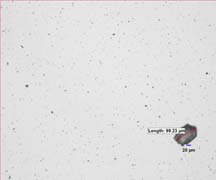
Large particle detection from an actuated dry powder inhaler (DPI).
Download Application Note 169: Particle Characterization of MDIs
Download Application Note 168: Particle Characterization of DPIs
View Webinar: Particle Size and Raman Evaluation of a Semi-Solid Dosage Form
Dynamic light scattering is the preferred technique for sub-micron particle size analysis. The SZ-100V2 Nanoparticle Analyzer measures particles size from 0.3 nanometer – 8 microns, zeta potential and molecular weight. The SZ-100V2 can be used for a variety of samples/applications including liposomes, dendrimers, proteins, viruses, and virus-like particles.
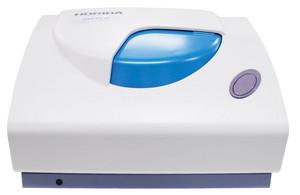
The SZ-100V2 Nanoparticle Analyzer measures particle size, zeta potential, and molecular weight.
The study of protein aggregation encompasses a broad range of interactions and mechanisms. Many studies into this subject area investigate the aggregation of mis-folded proteins, which is thought to be responsible for many degenerative diseases. Since aggregation typically leads to a physical change in protein size, particle size analysis has proven to be a useful experimental technique in this field.
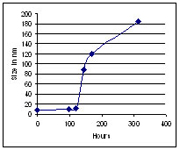
Download Application Note 221: Accurate Protein Aggregation Analysis
Liposomes are bilayer vesicles made of phospholipids derived from natural or man-made materials. They are mainly used in the pharmaceutical field for treatment of cancers as carriers of chemotherapeutic drugs to the tumor area. The amount of drug loaded into the liposomes and the size of the liposomes play pivotal roles in the pharmacokinetic and pharmacodynamic parameters of the drug. Hence accurate and rapid measurement of the size of liposomes is essential for novel and effective drug delivery systems.
The SZ-100 data shown below shows the particle size distribution of commercially available liposomes.
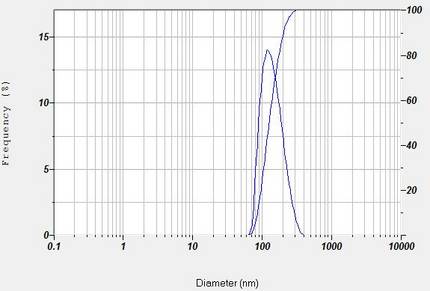
Particle size distribution for a liposomal material as measured by the SZ-100.
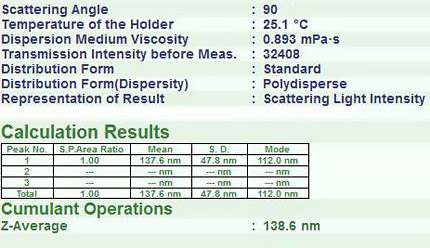
Particle size results for the liposome.
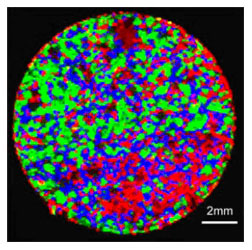
The ARAMIS from the HORIBA Jobin Yvon Raman Division provides information on particle properties including size, shape and chemical identification within final products such as tablets. This data is useful for investigating content uniformity, polymorphism, coating thicknesses, component mapping, and differentiation between amorphous and crystalline phases.
Now with the just released fast Raman mapping options SWIFT™ and DuoScan™ whole tablets like the 12.5mm diameter tablet shown above can be mapped in 10 minutes or less.
Dendrimers
The size of dendrimers is measured using dynamic light scattering.
Liposomes
The size of liposomes is measured using dynamic light scattering.
Viruses & Virus-Like Particles
The size of viruses and VLPs is measured using dynamic light scattering and laser diffraction.
Vaccine Manufacturing and Development
Viruses, VLP’s, and exosomes can be analyzed for size and concentration using multi-laser Nanoparticle Tracking Analysis (NTA).
Laser Scattering Particle Size Distribution Analyzer
Simultaneous Multi-Laser Nanoparticle Tracking Analysis (NTA)
Nanoparticle Analyzer
Do you have any questions or requests? Use this form to contact our specialists.